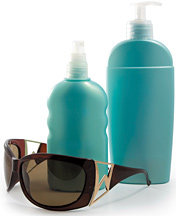Don't Burn Out (or Up)
Two Important Considerations When Exercising Outdoors This Summer
1. Proper Hydration: To burn fat, your cells need to be well-hydrated. When full of water, they're able to help burn fat. And because thirst can be mistaken as hunger, being well-hydrated can make it easier for you to follow a healthy nutrition plan.
 How can you tell if you're dehydrated? One way is by thirst. You may also get more headaches and feel tired more than usual. You might become more susceptible to colds, allergies, and joint pain, since your immune system will weaken. The advice to drink eight 8-ounce glasses of water a day is antiquated. Instead, multiply your weight in pounds by 0.5 and 0.7. The numbers generated are the range, in ounces, of water you should drink each day. There is no need to start slamming down water today. Instead, gradually increase your intake over a four-week period.
How can you tell if you're dehydrated? One way is by thirst. You may also get more headaches and feel tired more than usual. You might become more susceptible to colds, allergies, and joint pain, since your immune system will weaken. The advice to drink eight 8-ounce glasses of water a day is antiquated. Instead, multiply your weight in pounds by 0.5 and 0.7. The numbers generated are the range, in ounces, of water you should drink each day. There is no need to start slamming down water today. Instead, gradually increase your intake over a four-week period.
Also remember to make sure you always carry water with you during an outside workout or have it readily available. You do not want to risk heat stroke.
2. Skin Protection: The most effective way to decrease your exposure to the sun is by limiting time outside between 10:00 a.m. and 2:00 p.m., when the sun is generally the strongest.
 Anytime you are spending a lot of time outside, make sure to wear sunscreen with an SPF of 30 or more. SPF, an abbreviation for sun protection factor, indicates the degree of sunburn protection provided by the sunscreen.
Anytime you are spending a lot of time outside, make sure to wear sunscreen with an SPF of 30 or more. SPF, an abbreviation for sun protection factor, indicates the degree of sunburn protection provided by the sunscreen.
SPF is related to the total amount of sun exposure rather than simply the length of sun exposure. It is a common mistake to assume that the duration of effectiveness of a sunscreen can be determined simply by multiplying the SPF by the length of time it takes to suffer a burn without sunscreen, because the amount of sun exposure a person receives is dependent upon more than just the length of time spent in the sun.
The amount of sun exposure depends upon a number of factors including the length of exposure, time of day, geographic location, and weather conditions. A common mistake is applying too little sunscreen, which can drastically reduce the effective SPF of the product. About 1 ounce (5-6 teaspoons) of sunscreen is recommended to cover the entire body. Further, sunscreen must be reapplied every two hours when staying outdoors for a prolonged period of time. Sunscreen should also be applied at least 30 minutes before going outdoors. Remember to use sunscreen that holds up under intensive sweating. You are exercising and do not want it running into your eyes or wearing off.
Three Steps to a Successful Summer Workout
Warm up for 3 to 5 minutes. Start at a low intensity, gradually increasing pace during the course of the warm-up. Warm up can be a brisk walk or anything you choose to gradually increase your heart rate for 3-5 minutes.
Work for 3 to 5 minutes. For 30 seconds, go full speed (as fast as you can) with good form, doing one animal movement (crab walk, bear walk, etc.), followed by 20 seconds of a body-weight exercise (see sample exercise routine on page xx for details). Continue this back-and-forth sequence for four minutes (eight total intervals).
Recover for 3 to 5 minutes. After you perform the eight intervals, cool down slowly for three to five minutes with a walk.
Perform this routine three days per week in conjunction with any other form of fitness-related activities you enjoy on the off days.
Perry Nickelston, DC, is clinical director of the Pain Laser Center in Ramsey, N.J., where he focuses on performance enhancement, corrective exercise and metabolic fitness nutrition To learn more about Dr. Nickelston, visit www.painlasercenter.com/Our_Practice.html.

